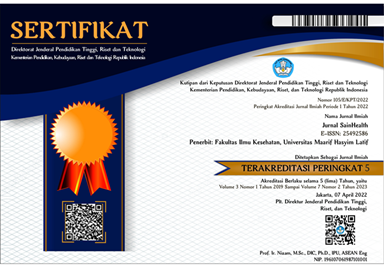PENGARUH VARIASI WAKTU SENTRIFUGASI NILAI HEMATOKRIT MENGGUNAKAN METODE MIKROHEMATOKRIT DI UNIVERSITAS BINAWAN
DOI:
https://doi.org/10.51804/jsh.v7i2.14334.51-57Abstract
Hematocrit is the total volume of red blood cells in 100 ml of blood expressed as a percentage of blood volume. Hematocrit examination is needed to help diagnose diseases such as anemia and dengue hemorrhagic fever (DHF) to determine the total volume of red blood cells or erythrocytes. The normal value for hematocrit examination is 40-54% for males and 37-47% for females. The purpose of this study was to determine the effect of variations in centrifugation time on hematocrit values using the microhematocrit method. This type of research is quantitative using experimental method with cross sectional design. The method used for hematocrit examination is the microhematocrit method with variations in centrifugation time of 2 minutes, 3 minutes, 4 minutes, and 5 minutes as a control with a speed of 12,000 rpm. The respondents of this study were 35 respondents and the samples of this study were 35 venous blood samples taken from Binawan University students, Medical Laboratory Technology Study Program batch 2021 and 2022. The average result of the 2-minute centrifugation hematocrit value examination is 37.87%, 3-minute centrifugation is 37.57%, 4-minute centrifugation is 37.30%, and 5-minute centrifugation is 37.25%. The Wilcoxon test results show the Sig. (2-tailed) of 2-minute centrifugation compared with 5 minutes is 0.00 (<0.05), 3-minute centrifugation compared with 5 minutes is 0.001 (<0.05), 4-minute centrifugation compared with 5 minutes is 0.560 (>0.05). The results of this study showed that hematocrit values with centrifugation times of 2 minutes and 3 minutes compared to 5 minutes had significant differences in hematocrit values.References
Gandasoebrata, R. 2010. Penuntun Laboratorium Klinik(16th ed.). Dian Rakyat
Jiwintarum, Y., Srigede, L., dan Asyhaer, R. K. 2020. Hematocrite Values With High Measurement Of Eritrosit After Centrifugation On Serum Making. Jurnal Analis Medika Biosains (JAMBS), 7(2), 112–121 https://doi.org/10.32807/jambs.v7i2.193
Meilanie, A. D. R. 2019. Different of Hematocrit Value Microhematocrit Methods and Automatic Methods in Dengue Hemorrhagic Patients With Hemoconcentration. Journal of Vocational Health Studies, 3(2), 67. https://doi.org/10.20473/jvhs.v3.i2.2019.67-71
Melinia, P. S. 2021. Pengaruh Kecepatan Dan Waktu Sentrifugasi Terhadap Kadar Hematokrit Mahasiswa Prodi DIII TLM Poltekkes Kemenkes Palembang Tahun 2021.
Nugraha, G., dan Badrawi, I. 2018. Pedoman Teknik Pemeriksaan Laboratorium Klinik. In Trans Info Media.
Nuraeni, M. 2020. Perbandingan Nilai Hematokrit Darah Vena Metode Automatik Dan Darah Kapiler Metode Mikro Hematokrit. Jurnal Kesehatan Saelmakers PERDANA, 3(2), 295–300.
Oktavia, N. A. 2016. Perbedaan Waktu dan Kecepatan Centrifuge terhadap Nilai Hematokrit Metode Mikrohematokrit, Universitas Muhammadiyah Semarang.
Pangestu, G. 2019. Gambaran Lama dan Kecepatan Kentrifugasi Terhadap Kadar Hematokrit pada Mahasiswa Semester VI D-III Analis Kesehatan STIKes ICMe Jombang. Progress in Retinal and Eye Research, 561(3),S2–S3.
Rasyada, A., Nasrul, E., dan Edward, Z. 2014. Artikel Penelitian Hubungan Nilai Hematokrit Terhadap Jumlah Trombosit pada Penderita Demam Berdarah Dengue. Jurnal Kesehatan Andalas, 3(3), 343–347
Saleh, R., Dwiyana, A., dan Parno. 2019. Pengaruh Variasi Waktu Centrifugasi Terhadap Hasil Pemeriksaan Hematokrit Metode Makro Pada Mahasiswa Program Studi D-III Analis Kesehatan. Jurnal Media Laboran, 9(2), 39–43. https://uit.ejournal.id/MedLAb/article/view/583/427
Downloads
Published
Issue
Section
License
Copyright (c) 2023 Jurnal SainHealth

This work is licensed under a Creative Commons Attribution 4.0 International License.
Jurnal SainHealth is licensed under Creative Commons Attribution 4.0 International License.
Under the following terms:
Attribution — You must give appropriate credit, provide a link to the license, and indicate if changes were made. You may do so in any reasonable manner, but not in any way that suggests the licensor endorses you or your use.
No additional restrictions — You may not apply legal terms or technological measures that legally restrict others from doing anything the license permits.
















